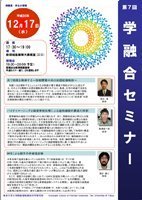AY2008 7th Gakuyugo Seminar
- Date&Time:
- Dec 17, 2008 17:30~19:00
- Venue:
- Large Lecture Room (2C0), New Frontier Science Bldg.

Controlling Matter with Light - Photo-Induced Phase Transitions in Strongly Correlated Electron Systems
Professor Hiroshi Okamoto
Such a phenomenon, in which the electronic structure and physical properties of a material are drastically changed by irradiating it with light, is called photo-induced phase transition, and is attracting attention in both basic and applied fields. In order to utilize this phenomenon as a function, the key is how to make the phase transition occur efficiently and at high speed. In this seminar, we will introduce our recent research on "ultrafast" photo-induced phase transitions in strongly correlated electron systems (transition metal oxides and organic molecular materials).

Analysis of plant intracellular structures by bioimaging and image information processing
Professor Seiichiro Hasezawa
The cells of higher plants do not have a well-defined centrosome, and chromosomes are distributed by forming septa with microtubule structures called septa-forming bodies, which are different from those of animal cells. In plant cells, the intracellular position and shape of the vacuole, which occupies a large volume, are deeply involved in cell growth. In plant cells, the intracellular position and shape of vacuoles, which occupy a large volume, are deeply involved in cell growth. Since these intracellular structures are thought to play a major role in the physical and structural aspects of plant cell division and differentiation, quantitative and integrated imaging analysis is necessary. For these reasons, our laboratory aims to analyze cellular structures such as nuclei, chromosomes, vacuoles, and cytoskeleton and their dynamics in the basic phenomena of plant cell division and differentiation using a unique method based on bioimaging and image information processing, and to clarify their structural relationships. (References) Kumagai-Sano, F., Hayashi, T., Sano, T. and Hasezawa, S. Cell cycle synchronization of tobacco BY-2 cells. Protocols 1: 2621-2627. Murata, T., Sonobe, S., Baskin, T.I., Hyodo, S., Hasezawa, S., Nagata, T., Horio, T. and Hasebe, M. Microtubule-dependent microtubule nucleation based on recruitment of γ-tubulin in higher plants. Nature Cell Biol. 7: 961-968. Nagata, T., Nemoto, Y. and Hasezawa, S. Tobacco BY-2 cell line as the "HeLa" cell in the cell biology of higher plants. Int Rev Cytol 132: 1-30.

Nondestructive diagnosis of trees using MRI
Professor Kenji Fukuda
Pine wilt (Pinus nematodes), which is rampant in many parts of Japan, is a wilt disease that causes leaves to die due to inhibition of water flow in the trunk (xylem) of pine trees. In order to understand the mechanism of wilt mortality, we have traditionally dissected pathogen-inoculated specimens and observed the xylem. However, such a destructive method does not allow us to fully understand the process of water penetration inhibition because the speed and pattern of disease development vary among individuals. To address this issue, we jointly developed a high-resolution MRI (MR microscope) for trees based on the principle of the nuclear magnetic resonance imaging (MRI) system used for diagnosis in hospitals, and constructed a nondestructive diagnostic system that allows us to observe the same individual tree over time and visualize the progress of water inhibition. This system can be applied to the observation of water inhibition caused by oak wilt (Fagus crenata) and wood damage, as well as to the study of water physiology in healthy plants.

